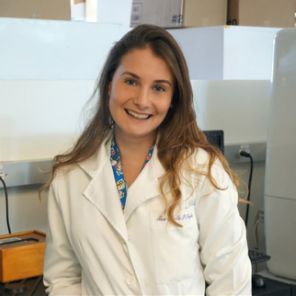
Ana Paula Piovezan Fugolin is a Postdoctoral Associate of the Department of Restorative Dentistry – Division of Biomaterials & Biomechanics at the Oregon Health & Science University, Portland. Dr. Fugolin obtained her D.D.S. (2008), Master’s Degree (2011) and Ph.D. in Dental Materials (2015) from the Piracicaba Dental School – State University of Campinas, Brazil. Her post-doc began in 2016 under the guidance of Carmem Pfeifer. Her research focuses on the development of innovative dental polymeric materials with increased toughness, reduced contraction stress, antimicrobial activity and higher resistance to hydrolytic and enzymatic degradation. Fuolin has been a member of the IADR since 2011 and is active within the IADR Dental Materials group.
How did you first learn about the AADOCR and what motivated you to join?
The first time I learned about the AADOCR was during my Master’s Degree in Brazil. We were encouraged to attend since it was an opportunity to be exposed to the most relevant research. Since I have started my postdoctoral program, more than just seeing what the outstanding researchers are working on, AADOCR is a valuable opportunity to present the research developed in the lab, get feedback and build a professional network.
Can you describe your research? How do you hope your work will impact others?
I believe I will have my own research when I become an independent faculty. As a postdoctoral student, I am part of a team focused on developing new monomers and oligomeric additives in order to reduce polymerization stress, hydrolytic and enzymatic degradation, which potentially means maximized survival rate of dental restorations. We hope our work encourages other people to come up with new strategies and ideas in real benefits for the patients.
As a student, where do you see yourself in 5-10 years?
In 5-10 years I see myself as an independent faculty member developing relevant researchers. My main goals are to: encourage and give opportunities for motivated people develop themselves, as my mentor does, and to see that my efforts can be reflected in real benefits for the patients.
Can you tell a story or give an example of how cross collaboration with other scientific disciplines has been important to your career?
I believe that cross-disciplinary collaboration should be a priority since it maximizes the impact of the research and benefits the biomedical community. In our department I have the opportunity to work with chemists, biologists, engineers and microbiologists, which have been teaching me to analyze the results under different perspectives and identify the need for complementary information. It has been completely changing my goals and expectations for my research and career since the cross collaboration introduced me to a higher and broader level of standards.
Can you describe your experience being a researcher from an underrepresented group in science?
Being a Latino woman in the Academy is a challenge and there are many barriers to be transposed. We have to face societal stereotypes and unconscious bias and work really hard to build a solid career. However, when we are in an environment surrounded by talented professors and researchers who offer encouragement to career development, autonomy and leadership, like where I am, it is easier to transpose any obstacle and foster competitiveness, unrestrained scientific inquiry, critical thinking, innovation and creativity.
Have you had the opportunity to mentor Underrepresented Minorities or work to increase diversity in science? If yes, can you describe your experience and what agencies/organizations you worked with?
So far I have not had this opportunity but certainly I want to do for other people from underrepresented minorities what my mentor does for me. I believe that is the best way to show my deepest gratitude for all opportunities I have been receiving.
Based on your experience, how would you encourage AADOCR members to help increase the diversity of the research workforce?
I believe that the diversity of the research workforce is translated in creativity, innovation and strength in terms of intellectual capital. We should foster an environment of authenticity and openness, where people can bring to the table their uniqueness. It opens unlimited new avenues of upbringings and approaches to doing things. Opportunities for internship programs would be a great strategy to start increasing the diversity of the research workforce.
What role do you think professional associations can play in supporting its members who are members of underrepresented minority/ethnic groups?
Professional associations could encourage PI’s to receive in their labs motivated members of underrepresented groups. I believe we just need equal opportunities to develop our careers. Everything else will be conquered through the hard work.




